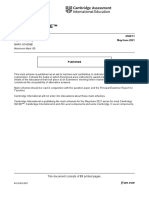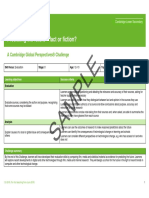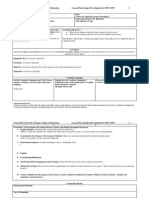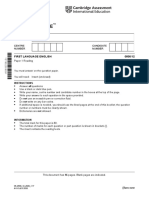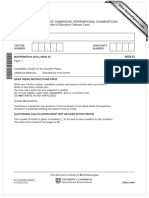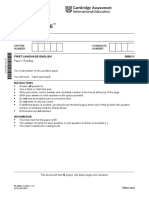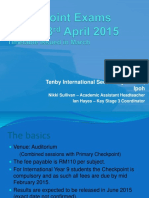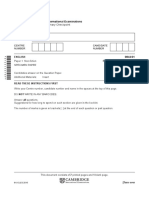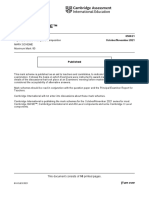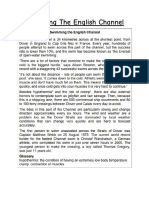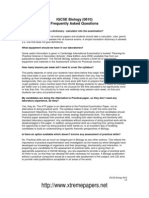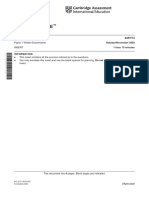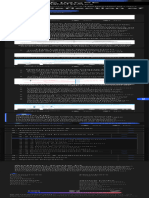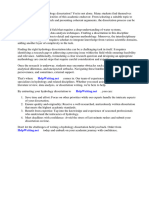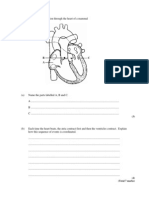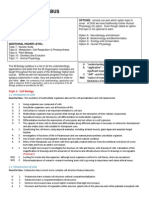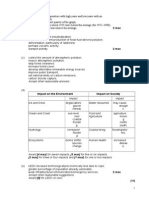Scheme of Work
Scheme of Work
Uploaded by
Vishnu SharmaCopyright:
Available Formats
Scheme of Work
Scheme of Work
Uploaded by
Vishnu SharmaOriginal Description:
Original Title
Copyright
Available Formats
Share this document
Did you find this document useful?
Is this content inappropriate?
Copyright:
Available Formats
Scheme of Work
Scheme of Work
Uploaded by
Vishnu SharmaCopyright:
Available Formats
s
er
ap
eP
e
tr
.X
w
om
.c
(IGCSE) (Environmental Management) (0680/02)
(unit 2): (Hydrosphere)
Recommended Prior Knowledge
An understanding of some processes from physical geography, hydrology and biology. While many physical geography text books for the GCSE include elements of all
three, typically they contain limited detail on diseases and life cycles in the oceans. Supplementary information can be obtained from GCSE science text books. An
appreciation of the importance of supplies of fresh water (as an increasingly limited natural resource), and of the role of dirty water in spreading diseases and
perpetuating poverty in the developing world. Awareness of increasing concern about the over-exploitation of marine resources.
Context
Although not essential, a good case can be made out for studying this unit second. Information about the water cycle, flooding, drought and ocean currents provides a
link with the later atmosphere unit. A similar link exists between water cycle and ecosystems, before the latter becomes a more specialised study in the biosphere unit.
Case studies are suggested, but it might be considered desirable to replace or supplemented these with examples more local to the Centre, or that are more topical at
the time of study.
Outline
The syllabus lay out for Hydrosphere is the same as for unit 1 Lithosphere. Separate topic areas within the Hydrosphere unit are followed through the four syllabus
columns. Content in column 1 is based on how natural cycles operate first on the land, and then in the oceans. How people use fresh water and exploit ocean
resources are the main themes running through column 2. The effects of human activities and actions are examined in column 3, before management strategies for
control and improvement are identified in column 4. The syllabus content is naturally divided into two parts, between water on the land and in the oceans, which makes
for two separate studies. Within each of the two parts, it makes sense to follow related themes through the columns; for example, to begin with natural sources of fresh
water in column 1, and follow it through to human demand and water uses in column 2, to water pollution from human use in column 3, and finally to the safe clean
water strategies outlined in column 4. Opportunities for students to re-use and extend their practical skills will continue to be suggested. Students should be encouraged
to keep up to date with topical events, such as floods, droughts, oil spills and continuing attempts to find a cure for malaria, a major killer of people living in the tropics.
AO
Learning outcomes
6.1
Water on the land
How the water cycle operates
Suggested Teaching activities
Learning resources
A good starting point is to make students aware that only 3 per cent of
water on Earth is fresh water, that in terms of human availability it is a
scarce resource, since so much is locked up in ice and snow. To give
students the opportunity to draw a labelled diagram to show how the
water cycle works and understand how the main processes operate. To
Environmental Management John
Pallister Oxford University Press, Karachi
Pakistan ISBN 10 019 597785 8 pages 5859
AO
6.3
6.2
8.2
8.3
Learning outcomes
The role of the water cycle within
ecosystems
How the natural availability of water
varies from place to place
Competing demands for water
Mismatch between water supply and
demand
Suggested Teaching activities
Learning resources
investigate source(s) of domestic water supplies and their reliability in
the students' home areas
Natural Economy 0670/02 June 1999
Question 1(a) Past Paper
Natural Economy 0670/02 Oct/Nov. 2002
Questions 1(a)(b) Past Paper
To introduce students to the concept of ecosystems, emphasising
interdependence, and to the vital importance of fresh water for all life on
Earth. To suggest student investigations, such as how vegetation cover
affects water cycle processes, and how natural vegetation changes
from the Equator to the tropics in response to reductions in rainfall.
Environmental Management pages 60-61
In order to demonstrate to students the wide variations in fresh water
availability, world maps in atlases can be studied (e.g. annual
precipitation, world water resources per head). Students can be guided
to identify areas of high and low water supply, and comment on the
relative level of water availability (whether water-rich or water-poor by
world standards) for their home country and world region.
Environmental Management pages 62- 64
To make students aware that competition operates at different levels
within a country (between water for domestic, industrial and agricultural
uses) and between countries (e.g. where large rivers flow through
several countries). To obtain water user percentages between sectors
for the home country and ask students to display them in a bar graph.
For case studies about competing demands for water both within one
country and between countries, Egypt and the River Nile Basin or water
use from the Rivers Tigris, Euphrates and Jordan in the Middle East are
suitable choices.
Environmental Management page 66
One approach is to focus upon water-poor countries with rapidly
increasing water demands, such as those in the Middle East like Saudi
Arabia, the UAE and Kuwait.
Natural Economy 0670/02 June 1999
Question 1(b) Past Paper
Natural Economy May/June 2003
Questions 1(a)(b) Past Paper
Natural Economy 0670/02 May/June 2003
Question 1(d) Past Paper
Natural Economy 0670/02 June 1999
Question 1(d) Past Paper
Environmental Management pages 65-66
AO
Learning outcomes
Suggested Teaching activities
Learning resources
8.1
Collection and control of water for a
variety of uses
To suggest that each student completes a spread sheet or
questionnaire about water uses by them and their family (in a day or for
a week). Class data can be collected and similarities and differences
commented on. Next they can be asked to consider whether (and why)
their water use is increasing. Then scale of the work can then be
changed, to ask them to give reasons (perhaps working in small
groups) why world consumption of water is increasing. To provide them
water use statistics for rich and poor continents/countries. Request
students to display them in divided bar or pie graphs, and to suggest
reasons for differences (i.e. why water use is so much greater in rich
countries).
To introduce students to the different types of natural water stores; to
ask them to draw a labelled sketch of an aquifer and check
understanding of the importance of permeable rock. To make a special
study of a large dam as an example of a human store (e.g. Aswan High
Dam, Three Gorges Dam, or one in the home country or region),
suggesting to students that they focus on both costs and benefits. As a
whole class discussion, to compare the advantages and disadvantages
of large and small dams.
Environmental Management pages 67-68
10.2
8.4
Contrasts in availability of water in
terms of quality, quantity and access
The ways in which processes operating
within the water cycle affect
development
After previous coverage of water availability, to concentrate here on
variations in water quality and access (between developed and
developing countries, and rural and urban areas within developing
countries). To ask students to draw graphs to highlight differences in
percentage access to safe water and sanitation between countries and
areas. To make a special study of a rural region where lack of access is
a major issue. To ask students to draw a spider diagram summarising
the reasons why access to safe water is poorer in rural areas.
To concentrate on the causes and effects of flooding and drought, begin
with a reminder of water cycle processes and to identify which one is
the principal physical cause of them. To make students aware that
humans contribute to causing them as well, by activities which change
Natural Economy 0670/02 June 1999
Questions 1(c)(i)-(iv) Past Paper
Environmental Management pages 69 to
75
Longman Geography for GCSE pages
222-3
Natural Economy 0670/02 May/June 2003
Questions 1(g)(h) Past Paper
Environmental Management 0680/02
May/June 2007 Questions 1(a)(b)(c) Past
Paper
Environmental Management pages 75-76
Web sites of charities such as
http://www.wateraid.org.uk
Natural Economy 0670/02 May/June 2002
Question 2(g) Past Paper
Environmental Management 0680/02
May/June 2007 Question 1(d) Past Paper
Environmental Management pages 77-81
http://www.bbc.co.uk/floods
AO
10.1
12.1
10.3
Learning outcomes
The causes and consequences of
water pollution
Ways of improving water quantity,
quality and access
The cycle of water-related diseases,
and their impact on human activities
and development
Suggested Teaching activities
Learning resources
land uses and alter how some water cycle processes operate. To give
students with a list of the effects of flooding and/or drought and ask
them to re-order them under particular headings e.g. immediate, shortterm and long term. To take advantage of the many case study
opportunities, such as for countries most at risk e.g. Bangladesh for
floods and African countries in the Sahel such as Niger for drought, or
use examples closer to home. In order to guide student investigation,
provide a framework of questions such as 'How regular are they?',
'When and why are they most likely to happen?' and 'What kinds of
damage do they cause?'.
http://www.bbc.co.uk/drought
To begin by directing students towards the three general human causes
of water pollution, namely agriculture, domestic and industry, and what
they add to groundwater and rivers that causes the pollution. To make a
special study of water pollution in the home area nature of the
pollution in two or three different locations, what has caused it, where it
is worst and why, whether the authorities have done anything to prevent
or reduce it. To introduce students to the process of eutrophication,
beginning with a definition and followed by how eutrophication affects
natural water ecosystems.
Environmental Management pages 81-83
To study an example of a river which has been improved, to act as an
example for how this could be achieved in streams which are still badly
polluted. Similarly to make a study of a village or region in the
developing world where access to a clean water has been provided.
Environmental Management pages 84-85
To explain to students the difference between 'water-based', 'waterborne' and 'water-bred' diseases, using the examples named in the
syllabus. To ask students to draw a circular flow diagram to show how
disease reduces the ability of people to work contributing to the cycle of
poverty and the poverty trap. To make a special study of one of these
diseases, using headings such as causes, symptoms and
consequences for people and their activities. Unless one of the named
diseases is locally much more important, the obvious choice is malaria
given its virulence and widespread distribution in developing countries.
Natural Economy 0670/02 June 1999
Questions 1(c)(v)-(vii) Past Paper
Natural Economy 0670/02 Oct/Nov.2002
Questions 1(e)(f) Past Paper
Environmental Management 0680/02
Oct/Nov. 2006 Question 1(c) Past Paper
ADB (Asian Development Bank) Review
January-February 2003
Environmental Management pages 86 to
88 and pages 90 to 91
Natural Economy 0670/02 May/June 2001
Question 1(g)(i) Past Paper
http://www.bbc.co.uk/malaria
AO
Learning outcomes
Suggested Teaching activities
Learning resources
To research statistics for the main causes of death in the home country
in order to assess relative importance of water-related diseases.
12.2
7.1
Strategies to control and eradicate
water-related diseases
The oceans
The role of the ocean as an
environment for interdependent
ecosystems
To make students aware of the difference between prevention and cure
of diseases, and why strategies for prevention are preferable whenever
possible. To direct students to work in small groups to think about and
discuss the problems of controlling and eradicating water related
diseases in poor rural areas in developing countries; to ask them to
draw a spider diagram identifying problems in order to summarise their
findings.
Environmental Management pages 88-91
To begin with a general introduction to the oceans, marine ecosystems,
their resource potential and why they may be vulnerable to overexploitation. To give students the opportunity to draw an example of a
marine ecosystem from primary producers (e.g. phytoplankton), to
zooplankton, to larger sized consumers such as fish, seals and whales
and finally the top carnivores (e.g. man and polar bears).
Environmental Management pages 92-93
7.2
The resource potential of the oceans
To focus student attention on the continental shelf, because it is the part
of the oceans with the greatest resource potential for humans. Begin
with an atlas study to determine locations where continental shelves are
wide; describe how continental shelves are physically from the rest of
the ocean, and explain why they are rich in marine life. To investigate
where oil and gas are extracted offshore from an atlas map showing the
world's oil fields.
9.2
Factors that limit full exploitation of the
ocean's potential resources
Class activity - to arrange students into two groups, one to discuss
reasons why drilling for oil from the sea bed is more expensive and
difficult than on land, and the other to come up with reasons why fishing
is s more hazardous activity than farming. Each group gives a summary
of reasons, from which individual students make a list of factors why
ocean resources are less easy to exploit fully than those on land.
7.3
The distribution of ocean currents and
To study an atlas map of oceans showing the currents, to recognise the
Natural Economy 0670/02 May/June 2001
Questions 1(g)(ii)-(iii) Past Paper
Environmental Management 0680/02
May/June 2007 Question 1(e) Past Paper
Environmental Management 0680/02
Oct/Nov. 2006 Question 1(d) Past Paper
Environmental Management pages 93-94
Environmental Management pages 94-96
AO
7.4
9.1
11.1
Learning outcomes
Suggested Teaching activities
their effects
different directions of flow of warm and cold currents, and to note the
effects of the continents and prevailing winds on their distribution. For
students, to mark and name on an outline map the currents in the
ocean(s) closest to their world region. To make students aware of the
strong relationship that exists between the presence of ocean currents
and the world's richest fishing grounds, and to discover reasons for it.
To guide students into the investigation of one example. A good choice
would be the Peruvian current and fishing grounds off the coast of Peru,
since it links in with the following study of el nino.
Reversal of ocean currents e.g. el nino
and its effects
To guide students into drawing two sets of directly comparable maps
and diagrams to show surface currents and underwater features in the
Pacific Ocean, one for a normal year and the other for an el nino year.
To explain the effects of this change for weather and human activities
both in Peru and the rest of the world. In an el nino year students can
keep a note of its effects from sources such as newspapers, TV
programmes and news based internet sites.
Environmental Management pages 97-98
Begin with a map of the world's major ocean fisheries and identify
named areas. Ask students where they can identify close relationships
between them and the presence of continental shelves and ocean
currents. To research data about total fish catches by country from
official websites and draw a graph to show the largest. To initiate a
class discussion about the different diets of people around the world
in which countries is fish consumption high, and why? To make a
special investigation of fishing in the home country or region to discover
whether or not fishing is important and why.
Environmental Management pages 99101
The environmental and human factors
in the distribution and exploitation of the
world's ocean fisheries
The implications of uncontrolled
exploitation of marine resources
To introduce students to the problem of overfishing and why it has
become a major international issue. To concentrate on the
improvements in technology which are leading to rapid reductions in
fish stocks. To make students aware that fish stocks also go up and
down due to natural causes e.g. in el nino years off the coast of Peru.
Learning resources
http://www.bbc.co.uk/elnino
Natural Economy 0670/02 May/June 2001
Questions 1(a)(b) Past Paper
http://www.FAO.org the official site of the
United Nations Food and Agricultural
Organisation
Environmental Management pages 101103
Environmental Management 0680/02
May/June 2004 Question 1(e)(i) Past Paper
Oct/Nov.2006 Questions 1(e)(f) Past Paper
AO
Learning outcomes
Suggested Teaching activities
Learning resources
13.1
Strategies for the sustainable
harvesting of ocean fisheries
To lead students into describing and explaining the four strategies
named in the syllabus, namely net types and sizes, quotas,
conservation laws and territoriality (e.g. restricted fishing areas to allow
breeding and fish stocks recovery). To emphasise to students that the
use of more than one method increases the chances of a better result.
To suggest possible case studies for further individual investigation,
bearing in mind varying degrees of success (e.g. low success Grand
Banks off Newfoundland and EU, high success non-EU countries such
as Iceland and Norway), or choose a more local regional example if
available. To make suggestions about how fishing can be made more
sustainable, such as more international cooperation, better rule
enforcement, more campaigns from environmental groups, then to
break the students up into discussion groups asking for ideas.
Environmental Management pages 103105
11.2
13.2
Causes of marine pollution and its
impact on the marine ecosystem and
on coastal zones
Marine pollution controls and remedial
action
To identify the main types of materials responsible for marine pollution
(nutrients, sediments, pathogenic organisms, plastics and other litter,
oil, toxic wastes and radioactive wastes), their main sources and
impacts. To guide students into an individual investigation of a major oil
spill by providing working headings related to syllabus need, such as
location, size of spill, causes, effects on wildlife, effects on people and
attempts made to reduce these effects. While a recent spill widely
covered by the international news media is always best, some earlier
incidents are well documented, such as the Exxon Valdez in Alaska
(1989) and during the Gulf War (1991).
To stress the importance of international cooperation in preventing the
disaster from happening in the first place, and in providing equipment
and know-how to poor countries after the disaster has occurred. To
identify some of the methods used for prevention, such as tankers with
Environmental Management 0680/02
May/June 2004 Questions 1(e)(ii)-(iii) Past
Paper
Oct/Nov. 2006 Question 1(g) Past Paper
http://news.bbc.co.uk/2/hi/science/nature61
08414.stm
Environmental Management pages 106108
Longman Geography for GCSE pages
236-7
Exxon Valdez oil spill
http://evostc.state.ak.us/History/
Natural Economy 0670/02 May/June 2001
Question 1(c) Past Paper
Environmental Management 0690/02
Oct/Nov. 2006 Questions 1(a)(b) Past
Paper
Environmental Management pages 109110
AO
Learning outcomes
Suggested Teaching activities
a double hull, and for remedial action, such as booms, detergent sprays
and skimmers. To look for local, national or regional opportunities for a
more detailed study of marine pollution coming from the land, such as
from a heavy industrial works next to the sea or from a river entering the
sea after passing through large urban / industrial areas.
Learning resources
You might also like
- 0610 Scheme of Work (For Examination From 2023)Document92 pages0610 Scheme of Work (For Examination From 2023)Sope KolsNo ratings yet
- 0530 Example Candidate Responses Paper 4 (For Examination From 2021)Document29 pages0530 Example Candidate Responses Paper 4 (For Examination From 2021)Rin LoiroNo ratings yet
- Cambridge Checkpoint Science English Language Skills Teachers SupportDocument14 pagesCambridge Checkpoint Science English Language Skills Teachers SupportDanilo Pereira GonçalvesNo ratings yet
- Latch Type Drilling JAR ManualDocument41 pagesLatch Type Drilling JAR ManualMuhammad Zikry Alfindy HazNo ratings yet
- Tiny Dungeon 2nd - Treasure DeckDocument104 pagesTiny Dungeon 2nd - Treasure DeckJacobo CisnerosNo ratings yet
- Cambridge IGCSE™: First Language English 0500/11 May/June 2021Document21 pagesCambridge IGCSE™: First Language English 0500/11 May/June 2021Cotton CandyNo ratings yet
- Stage 7 English Curriculum Framework PDFDocument3 pagesStage 7 English Curriculum Framework PDFMangunatun KhasanahNo ratings yet
- Ess Revision NotesDocument36 pagesEss Revision NotesVishnu Sharma100% (8)
- Load Flow StudiesDocument54 pagesLoad Flow Studiesk rajendra100% (1)
- Heat of Neutralization Formal ReportDocument16 pagesHeat of Neutralization Formal ReportReymar Suello Ungab100% (6)
- IGCSE Biology 0610-PracticalDocument5 pagesIGCSE Biology 0610-PracticalRuhansa de SilvaNo ratings yet
- English Paper 1Document14 pagesEnglish Paper 1KRISHNANo ratings yet
- English Stage 7 2014 02 tcm143-372186Document10 pagesEnglish Stage 7 2014 02 tcm143-372186ghanateachergalNo ratings yet
- English Past PapersDocument48 pagesEnglish Past PapersMiracle JosiahNo ratings yet
- 2023 Chemistry 0620 Specimen PapersDocument66 pages2023 Chemistry 0620 Specimen PapersClevxyNo ratings yet
- Science Curriculum Framework 0893 - tcm143-595685Document31 pagesScience Curriculum Framework 0893 - tcm143-595685binduNo ratings yet
- Cambridge International AS Level: English General Paper 8021/11 May/June 2021Document16 pagesCambridge International AS Level: English General Paper 8021/11 May/June 2021dontspreadaboutme100% (2)
- Biology Tips and TricksDocument1 pageBiology Tips and TricksDr Ahmed ReyadNo ratings yet
- Grade 6 Science Term Test PapersDocument8 pagesGrade 6 Science Term Test Papersafmzatvuipwdal50% (2)
- Unit4 TextsDocument7 pagesUnit4 TextsMustafa Al Qady100% (1)
- Sample: Predicting The Future - Fact or Fiction?Document4 pagesSample: Predicting The Future - Fact or Fiction?Shail DarbariNo ratings yet
- 0500 Scheme of Work (For Examination From 2024)Document62 pages0500 Scheme of Work (For Examination From 2024)Hussey Shah100% (1)
- Cambridge IGCSE: 0450/21 Business StudiesDocument12 pagesCambridge IGCSE: 0450/21 Business StudiesTamer AhmedNo ratings yet
- Grade IX Parent Orientation PPT 2023-24Document88 pagesGrade IX Parent Orientation PPT 2023-24Reyna ChandakNo ratings yet
- Cambridge Lower Secondary Science Curriculum Outline PDFDocument2 pagesCambridge Lower Secondary Science Curriculum Outline PDFThe DevilzNo ratings yet
- Physics ATP Analysis by Vasumitra GajbhiyeDocument6 pagesPhysics ATP Analysis by Vasumitra GajbhiyeBianca WoanyahNo ratings yet
- Lesson Plan AbcyaDocument2 pagesLesson Plan Abcyaapi-27345155350% (2)
- Cambridge IGCSE: 0500/12 First Language EnglishDocument16 pagesCambridge IGCSE: 0500/12 First Language EnglishJonathan ChuNo ratings yet
- Cambridge IGCSE: GEOGRAPHY 0460/12Document28 pagesCambridge IGCSE: GEOGRAPHY 0460/12Rufat AsgarovNo ratings yet
- Maths p12 PDFDocument20 pagesMaths p12 PDFNatsu DragneelNo ratings yet
- Cambridge IGCSE: 0500/11 First Language EnglishDocument16 pagesCambridge IGCSE: 0500/11 First Language EnglishmyrahNo ratings yet
- Scheme of Work English Stage 7 v1Document36 pagesScheme of Work English Stage 7 v1Wisdom PhanganNo ratings yet
- Checkpoint Exams SecondaryDocument22 pagesCheckpoint Exams SecondaryTharrshiny Selvaraj100% (2)
- Solved 0580 - m16 - QP - 22..''..typedDocument13 pagesSolved 0580 - m16 - QP - 22..''..typedJohn Raza100% (1)
- Challenge Workbook 9 Answers: Unit 1 PlantsDocument29 pagesChallenge Workbook 9 Answers: Unit 1 PlantsLizaaNo ratings yet
- Revision Notes Language Techniques (Year 8)Document28 pagesRevision Notes Language Techniques (Year 8)Doaa Zakaria Ali100% (1)
- Lesson Plan - Week 6 and 7Document4 pagesLesson Plan - Week 6 and 7anupamaNo ratings yet
- Scheme of Work: Cambridge IGCSE / Cambridge IGCSE (9-1) First Language English 0500 / 0990Document55 pagesScheme of Work: Cambridge IGCSE / Cambridge IGCSE (9-1) First Language English 0500 / 0990Amalia ZabalaNo ratings yet
- April 2021 Caie p2 Questions 1111 English Cambridge Lower Secondary CheckpointDocument9 pagesApril 2021 Caie p2 Questions 1111 English Cambridge Lower Secondary CheckpointVipula DissanayakeNo ratings yet
- Cambridge Past Papers Cambridge Solved Past PapersDocument1 pageCambridge Past Papers Cambridge Solved Past PaperscwfkbscsdvNo ratings yet
- F2 Mathematics Foundation Ii Mathematics Assignment 4: © Cambrilearn - All Rights ReservedDocument12 pagesF2 Mathematics Foundation Ii Mathematics Assignment 4: © Cambrilearn - All Rights ReservedlunalovegoodsNo ratings yet
- Mole Calculation IGCSE Chemistry WorksheetDocument3 pagesMole Calculation IGCSE Chemistry WorksheetKingdom Schools FansNo ratings yet
- Science Paper 1: Stage 8Document12 pagesScience Paper 1: Stage 8tranthihuong205No ratings yet
- Ket 4 - Test 4Document9 pagesKet 4 - Test 4Thànhh LongNo ratings yet
- English Specimen Paper 1 2018 PDFDocument8 pagesEnglish Specimen Paper 1 2018 PDFAsish GeiorgeNo ratings yet
- 2019 Speciman Paper 1Document12 pages2019 Speciman Paper 1Anitha NathenNo ratings yet
- Cambridge International AS & A Level: Biology 9700/33Document6 pagesCambridge International AS & A Level: Biology 9700/33张查No ratings yet
- Cambridge IGCSE™: First Language English 0500/21 October/November 2021Document10 pagesCambridge IGCSE™: First Language English 0500/21 October/November 2021Iman HamedNo ratings yet
- Swimming The English ChannelDocument3 pagesSwimming The English ChannelLee MaiaNo ratings yet
- IGCSE Biology (0610) Frequently Asked QuestionsDocument3 pagesIGCSE Biology (0610) Frequently Asked QuestionsAnjai JacobNo ratings yet
- Beach Descriptive EssayDocument2 pagesBeach Descriptive EssayMayank MaddulaNo ratings yet
- 0580 w17 QP 22Document12 pages0580 w17 QP 22santhiNo ratings yet
- Cambridge IGCSE: Global Perspectives 0457/13Document4 pagesCambridge IGCSE: Global Perspectives 0457/13Asnehdeep Sudan0% (1)
- 8624 Assignment 2Document32 pages8624 Assignment 2Majid KhanNo ratings yet
- Cambridge Lower Secondary Mathematics and The National Curriculum For England 0862 - tcm143-595682Document30 pagesCambridge Lower Secondary Mathematics and The National Curriculum For England 0862 - tcm143-595682onyamenaayestreetNo ratings yet
- Unit 8Document15 pagesUnit 8sapna sinhaNo ratings yet
- Cambridge International AS Level: English General Paper 8021/13Document4 pagesCambridge International AS Level: English General Paper 8021/13Ankit MardaNo ratings yet
- Cambridge IGCSE: 0500/11 First Language EnglishDocument8 pagesCambridge IGCSE: 0500/11 First Language EnglishJonathan ChuNo ratings yet
- Answers To End-Of-Chapter QuestionsDocument2 pagesAnswers To End-Of-Chapter QuestionsAjay LakshmananNo ratings yet
- IGCSE Parent Orientation 2022-23Document80 pagesIGCSE Parent Orientation 2022-23Jay SharmaNo ratings yet
- Volunteers Wanted: To Welcome Visitors To Our SchoolDocument3 pagesVolunteers Wanted: To Welcome Visitors To Our SchoolBreezy BrownNo ratings yet
- Paper 2 Updated 1123 - Y24 - SP - 2Document4 pagesPaper 2 Updated 1123 - Y24 - SP - 2Hafiz Muhammad Waqas100% (1)
- Reflection of Light (3.2.1) CIE IGCSE Physics Revision Notes 2023 Save My ExamsDocument1 pageReflection of Light (3.2.1) CIE IGCSE Physics Revision Notes 2023 Save My ExamsMuhammadAbdullah32No ratings yet
- Hydrology Dissertation IdeasDocument8 pagesHydrology Dissertation IdeasBuyWritingPaperElgin100% (1)
- Water Resources Engineering Thesis TopicsDocument9 pagesWater Resources Engineering Thesis Topicskarawebberoverlandpark100% (3)
- Isotonic Point of A PotatoDocument12 pagesIsotonic Point of A PotatoVishnu Sharma100% (1)
- Unit 1-Heat CVD Lungs CF QuestionsDocument73 pagesUnit 1-Heat CVD Lungs CF Questionsareyouthere9267% (3)
- Ib Biology Syllabus-NewDocument20 pagesIb Biology Syllabus-NewVishnu SharmaNo ratings yet
- Enzymes: Seria L No. Questions 1) (w13 Qp11)Document8 pagesEnzymes: Seria L No. Questions 1) (w13 Qp11)Vishnu SharmaNo ratings yet
- Environmental Systems & Societies Notes: Topic 1: Systems and ModelsDocument9 pagesEnvironmental Systems & Societies Notes: Topic 1: Systems and ModelsVishnu SharmaNo ratings yet
- Plant Nutrition: Serial No. QuestionsDocument4 pagesPlant Nutrition: Serial No. QuestionsVishnu SharmaNo ratings yet
- 0620 s05 Ms 1Document4 pages0620 s05 Ms 1Vishnu SharmaNo ratings yet
- MCQ Bank Igcse BiologyDocument24 pagesMCQ Bank Igcse BiologyVishnu SharmaNo ratings yet
- 2nd Chap QnbankDocument21 pages2nd Chap QnbankVishnu SharmaNo ratings yet
- Transport in Plants: Serial No. Questions 1) (w13 Qp11)Document7 pagesTransport in Plants: Serial No. Questions 1) (w13 Qp11)Vishnu SharmaNo ratings yet
- Test Bio2Document5 pagesTest Bio2Vishnu SharmaNo ratings yet
- Paper Ess MsDocument6 pagesPaper Ess MsVishnu SharmaNo ratings yet
- Variation & Selection: Seria L No. Questions 1) (w12 Qp11)Document2 pagesVariation & Selection: Seria L No. Questions 1) (w12 Qp11)Vishnu SharmaNo ratings yet
- Test Bio2Document5 pagesTest Bio2Vishnu SharmaNo ratings yet
- C5c Concentration and Quantitative AnalysisDocument5 pagesC5c Concentration and Quantitative AnalysisVishnu SharmaNo ratings yet
- MoleDocument9 pagesMoleVishnu SharmaNo ratings yet
- C5a Moles and Empirical Formulae: Relative Formula Mass Calculations - RevisionDocument14 pagesC5a Moles and Empirical Formulae: Relative Formula Mass Calculations - RevisionVishnu SharmaNo ratings yet
- O o o O: Name: Grade: Date: Percent MassDocument1 pageO o o O: Name: Grade: Date: Percent MassVishnu SharmaNo ratings yet
- Biotechnology and Genetic Engineering: Seri Al No. QuestionsDocument2 pagesBiotechnology and Genetic Engineering: Seri Al No. QuestionsVishnu SharmaNo ratings yet
- En 1Document8 pagesEn 1Vishnu SharmaNo ratings yet
- Lyrics of The Ordinary MassDocument6 pagesLyrics of The Ordinary Masslito77No ratings yet
- Practical 14-CANNING OF GREEN MUSSELS IN MASALADocument3 pagesPractical 14-CANNING OF GREEN MUSSELS IN MASALABharathi PriyaNo ratings yet
- ERPH 2022 EnglishDocument14 pagesERPH 2022 EnglishSarveena MurugiahNo ratings yet
- Science Daily Lesson l44Document48 pagesScience Daily Lesson l44Audie Nocedo MontecastroNo ratings yet
- Amoxicillin For Bacterial InfectionsDocument2 pagesAmoxicillin For Bacterial InfectionsWilliam ImpNo ratings yet
- Social Studies Multiple ChoiceDocument8 pagesSocial Studies Multiple ChoiceTraffic DepartmentNo ratings yet
- Indian Institute of Technology RoorkeeDocument60 pagesIndian Institute of Technology RoorkeeTOKEN PRINTNo ratings yet
- Intro. To HumanitiesDocument15 pagesIntro. To HumanitiesEdlyn ResuelloNo ratings yet
- EDC-DTS-MV016 - Stay Wire and AccessoriesDocument27 pagesEDC-DTS-MV016 - Stay Wire and AccessoriesJoe bilouteNo ratings yet
- Cell Injury and Cellular AdaptationDocument30 pagesCell Injury and Cellular AdaptationAngelita RuntukNo ratings yet
- Annex 21.1.1: Name of Ship Certificate No. ............... Official Number Call Sign Port of Registry Name of OwnerDocument1 pageAnnex 21.1.1: Name of Ship Certificate No. ............... Official Number Call Sign Port of Registry Name of OwnerRihardsNo ratings yet
- Mozambique Power SectorDocument22 pagesMozambique Power SectorEdgar Manuel CambazaNo ratings yet
- NCLEX Practice Exam For Pediatric Nursing 2 - RNpediaDocument14 pagesNCLEX Practice Exam For Pediatric Nursing 2 - RNpediaLot Rosit100% (1)
- Astm B26 - B26M-2011 - 5343Document3 pagesAstm B26 - B26M-2011 - 5343jaskaran singh0% (1)
- A New Approach For The Study of Silt Erosion of Hydro TurbineDocument4 pagesA New Approach For The Study of Silt Erosion of Hydro TurbinePashupati MandalNo ratings yet
- P3D PMDG 747 400 GuideDocument164 pagesP3D PMDG 747 400 Guidecatchman8683% (6)
- Unit 2 - Speech OrganDocument11 pagesUnit 2 - Speech OrganAgnes Evi Rosauly SiahaanNo ratings yet
- Grade 2 Quiz ChartQ2Document4 pagesGrade 2 Quiz ChartQ2Astro GuillermoNo ratings yet
- Ketogains Calculator Reddit v1.9Document4 pagesKetogains Calculator Reddit v1.9nial69No ratings yet
- Atom Sunflower Warmer Operation ManualDocument64 pagesAtom Sunflower Warmer Operation ManualGunma AkagiNo ratings yet
- Colon CancerDocument6 pagesColon CancerSavithri SavithriNo ratings yet
- Application of Remote Sensing and GIS Final Exam Spot QuestionDocument1 pageApplication of Remote Sensing and GIS Final Exam Spot QuestionAtfi Mohd RazaliNo ratings yet
- 020508-Bill of Material JPL Project - CAT IDocument6 pages020508-Bill of Material JPL Project - CAT ISunny SharmaNo ratings yet
- Weber - Dry Seal: (Flexible Acrylic Waterproofing)Document2 pagesWeber - Dry Seal: (Flexible Acrylic Waterproofing)Anthony Thaddeus AntonioNo ratings yet
- Beef Cattle QuestionsDocument5 pagesBeef Cattle QuestionsTitus NightbladeNo ratings yet
- ELPD DC21 - 13 - 07 - Epson Document CameraDocument12 pagesELPD DC21 - 13 - 07 - Epson Document CameraCandy ChanNo ratings yet





